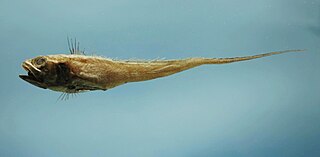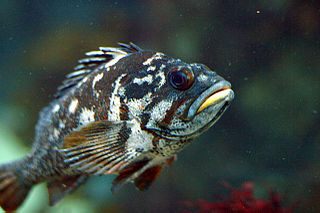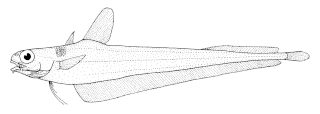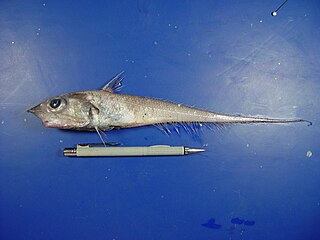
Cod is the common name for the demersal fish genus Gadus, belonging to the family Gadidae. Cod is also used as part of the common name for a number of other fish species, and some species suggested to belong to genus Gadus are not called cod.

Pollock is the common name used for either of the two species of North Atlantic marine fish in the genus Pollachius. Pollachius pollachius is referred to as pollock in both North America and the United Kingdom, while Pollachius virens today is usually known as coley in the British Isles. Other names for P. pollachius include the Atlantic pollock, European pollock, lieu jaune, and lythe; while P. virens is also known as Boston blue, silver bill, or saithe.

Gadiformes are an order of ray-finned fish, also called the Anacanthini, that includes the cod and its allies. Many major food fish are in this order. They are found in marine waters throughout the world and the vast majority of the species are found in temperate or colder regions. A few species may enter estuaries but only one, the burbot, is a freshwater fish.

The Merlucciidae are a family of cod-like fish, including most hakes. They are native to cold water in the Atlantic and Pacific Oceans, and typically are found at depths greater than 50 m (160 ft) in subtropical, temperate, sub-Arctic or sub-Antarctic regions.

Boreogadus saida, known as the polar cod or as the Arctic cod, is a fish of the cod family Gadidae, related to the true cod. Another fish species for which both the common names Arctic cod and polar cod are used is Arctogadus glacialis.

Gadus is a genus of demersal fish in the family Gadidae, commonly known as cod, although there are additional cod species in other genera. The best known member of the genus is the Atlantic cod.
Arctogadus glacialis, known also with ambiguous common names Arctic cod and polar cod, is an Arctic species of fish in the cod family Gadidae, related to the true cod. Arctogadus glacialis is found in icy water. They grow to about 30 cm long, and are favorite food of narwhals and other arctic whales.
The East Siberian cod also known as the toothed cod, is an Arctic fish closely similar to the Arctic cod Arctogadus glacialis and also related to true cods. It has been differentiated in appearance from the Arctic cod by having pronounced chin barbel. Their sides and back are dark olive and the belly are light grey with dark spots. They may grow up to 60 cm.

Macroudidae is a family of deep sea fish, a diverse and ecologically important group, which are part of the order of cod-like fish, the Gadiformes. The species in the Macrouridae are characterised by their large heads which normally have a single barbel on the chin, projecting snouts, and slender bodies that taper to whip-like tails, without an obvious caudal fin but what there is of the caudal fin is often confluent with the posterior dorsal and anal fins. There are normally two dorsal fins, the anterior dorsal fin is quite high, the posterior quite low but is longer and takes up a greater proportion of the fish's of the back, species in the subfamily Macrouroidinae have a single dorsal fin. The long anal fin is almost as long as the second dorsal fin is nearly as long as the posterior dorsal, and sometimes it is longer. The pelvic fin is inserted in the vicinity of the thorax and normally has 5-17 fin rays but are absent in Macrouroides. The body is covered in small scales and if they have a photophore, it is usually on the midline of the abdomen just in front of the anus. The bioluminescence of these fish is produced by symbiotic bioluminescent bacteria. The structure of the skull has been used to show their placing in the Gadiformes, but they differ from the typical cods in that they possess one stout spine in the anterior dorsal fin.

Sebastidae is a family of marine fish in the order Scorpaeniformes. Their common names include rockfishes, rock perches, ocean perches, sea perches, thornyheads, scorpionfishes, sea ruffes and rockcods. Despite the latter name, they are not closely related to the cods in the genus Gadus, nor the rock cod, Lotella rhacina.

Sprat is the common name applied to a group of forage fish belonging to the genus Sprattus in the family Clupeidae. The term also is applied to a number of other small sprat-like forage fish. Like most forage fishes, sprats are highly active, small, oily fish. They travel in large schools with other fish and swim continuously throughout the day.
Melanonus is a genus of gadiform fishes containing just two species of cod-like marine fishes. This is the only genus in the family Melanonidae.

The grenadier cod or chiseltooth grenadier cod, Tripterophycis gilchristi, is a morid cod of the genus Tripterophycis, found in the mid-south Atlantic Ocean, and around southern Australia, South Africa, Sumatra, and New Zealand. This species is found in marine environments on the continental slope.

The silver hake, Atlantic hake, or New England hake is a merluccid hake of the genus Merluccius, found in the northwest Atlantic Ocean. It is highly predatory and typically feeds on fish and crustaceans.

Pollachius pollachius is a species of marine fish in the Pollachius genus. FAO uses the English name pollack for this species. Together with Pollachius virens, it may also be referred to as pollock. Other names include European pollock, lieu jaune, and lythe. It is common in the north-eastern parts of the Northern Atlantic, including the Bay of Biscay and North Sea. Adults can grow up to 130 cm (51 in) and weigh up to 18.1 kg (40 lb), although more commonly their maximum length is 75 cm (30 in).

Macrourus is a small benthopelagic genus of rattails from the family Macrouridae.

Nezumia is a genus of rattails.

Trachyrincus is a genus of rattail fish in the family Trachyrincidae.

Gadella is a genus of morid cod. The species in this genus are characterised by the absence of a chin barbell, an anterior dorsal fin with 7-11 rays, a long based anal fin which has a straight profile, the outermost rays of the pelvic fin are filamentous and extend a small distance beyond the membrane. They do not have a photophore. The Gadella codlings are found around the tropical and subtropical seas around the world on the outer continental shelf to the mid continental slope. They are of no interest to fisheries.
Macruronus is a genus of merluccid hakes. Most are found in southern oceans off Argentina, Chile, South Africa, Australia and New Zealand, but M. maderensis is only known from Madeira. Members of this genus reach 1–1.3 m (3.3–4.3 ft) in length depending on the exact species involved.















